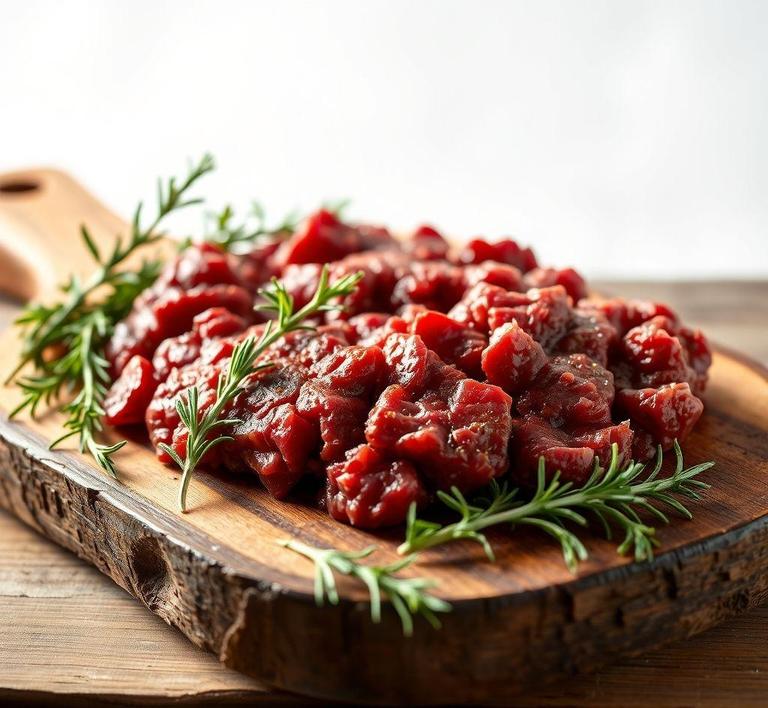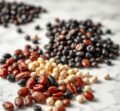If you’re wondering whether you can safely refreeze ground venison, you’re not alone! Many people love the rich, lean taste of venison, but sometimes you end up with more than you can cook right away. Fortunately, with proper handling, it’s totally possible to refreeze ground venison without sacrificing its flavor or safety. The key is to follow a few simple steps to ensure the meat stays fresh and maintains its texture. So, if you’ve thawed some ground venison and are considering putting it back in the freezer, this guide will walk you through what you need to know to do it the right way!
Can You Refreeze Ground Venison?

Ground venison, like any ground meat, is highly perishable and requires careful handling to maintain safety and quality. The question of whether you can refreeze ground venison is common among hunters and cooks alike, especially when dealing with excess meat or leftovers.
Technically, yes, you can refreeze ground venison, but there are important caveats. Refreezing is generally safe only if the meat has been thawed properly and has not been left at unsafe temperatures for extended periods. This means the venison should have been thawed in the refrigerator at or below 40°F (4°C), never left out on the counter or in warm conditions where bacteria can multiply rapidly. If the meat has been thawed in cold water or the microwave, it should be cooked immediately and not refrozen raw.
Refreezing ground venison that has been thawed slowly in the refrigerator minimizes the risk of bacterial growth, but each thaw and refreeze cycle can impact the texture and taste due to moisture loss and the breakdown of muscle fibers. While refreezing is safe under the right conditions, it’s generally recommended to avoid multiple freeze-thaw cycles to preserve the best quality of your venison.
How To Refreeze Ground Venison?
If you find yourself needing to refreeze ground venison, follow these detailed steps to ensure safety and maintain as much quality as possible:
-
Thaw Properly in the Refrigerator
When thawing your ground venison, plan ahead so it thaws slowly and evenly in the refrigerator. This keeps the meat at a consistent safe temperature and prevents bacterial growth.
-
Inspect the Meat
Before refreezing, check the venison for any off smells, discoloration, or slimy texture. Any signs of spoilage mean the meat should be discarded. Fresh, neutral-smelling meat is safe to refreeze.
-
Portion Before Refreezing
Divide the venison into meal-sized portions. This prevents repeatedly thawing large quantities when you only need a small amount, preserving the rest in perfect condition.
-
Use Airtight Packaging
Wrap the meat tightly in plastic wrap or aluminum foil, then place it in a heavy-duty freezer bag or vacuum-sealed packaging. Removing air prevents freezer burn and moisture loss, both of which degrade meat quality.
-
Label and Date
Always label your packages with the date before freezing. Ground venison can be stored safely for about 3 to 4 months for best quality, but using older meat increases the risk of freezer burn and diminished flavor.
-
Freeze Promptly
Place the wrapped meat in the coldest part of the freezer to freeze it as quickly as possible, which helps reduce the formation of large ice crystals that can damage the meat’s texture.
If you cooked the venison after thawing, you can refreeze the cooked leftovers safely as well. Cooked meat tends to freeze better because the cooking process kills surface bacteria, and refreezing leftovers doesn’t impact food safety as much as refreezing raw meat.
Quality Impact
Repeated freezing and thawing can have a noticeable impact on the texture, moisture content, and overall flavor of ground venison. Each cycle causes ice crystals to form and melt inside the meat’s cellular structure. These ice crystals rupture the cell walls, leading to moisture loss during thawing, which can leave the meat dry and crumbly rather than juicy and tender.
Moreover, ground venison is leaner than many other meats, which means it has less fat to retain moisture. This makes it more vulnerable to drying out and developing an off-putting texture after refreezing. The delicate game flavor might also be muted or altered due to moisture loss and oxidation during freezing.
Freezer burn is another risk, appearing as grayish-brown leathery patches on the surface caused by air exposure. While freezer-burned meat is safe to eat, it is often tough and flavorless.
To minimize quality degradation:
- Always use airtight, vacuum-sealed packaging.
- Avoid multiple freeze-thaw cycles.
- Freeze quickly and thaw slowly in the refrigerator.
- Use the refrozen venison in cooked dishes like stews, chili, or casseroles where texture is less critical.
You can refreeze ground venison, but only under strict conditions that prioritize food safety and quality preservation. Thawing in the refrigerator and ensuring the meat has never been at unsafe temperatures are essential to avoid foodborne illness. While refreezing may be a practical solution to avoid waste, it inevitably affects the texture and flavor due to moisture loss and cellular damage.
To enjoy the best flavor and texture, it’s best to portion your ground venison carefully and avoid repeated freeze-thaw cycles. If refreezing is necessary, proper packaging, quick freezing, and thoughtful meal planning can help maintain the integrity of your prized wild game meat. And remember, cooked venison leftovers freeze better than raw venison-so when in doubt, cook it first.
With these practices, you can confidently manage your venison supply while savoring the delicious, lean, and wild flavors unique to this exceptional meat.
Is It Safe To Refreeze Ground Venison?
Ground venison, like all meats, is highly perishable and requires careful handling to prevent foodborne illnesses. The question of whether you can safely refreeze ground venison depends largely on how it has been stored and handled after its initial thaw.
The general rule: You can refreeze ground venison only if it has been thawed properly in the refrigerator and has not been left out at unsafe temperatures. When meat is thawed in the fridge, the temperature remains low enough to inhibit bacterial growth. Under these conditions, refreezing is safe, although some quality loss can occur due to moisture loss and texture changes.
However, if the ground venison was thawed using faster methods, such as leaving it out on the counter or thawing in warm water, the meat could have spent too much time in the ‘danger zone’ (40°F-140°F or 4°C-60°C), where bacteria multiply rapidly. In this case, refreezing is unsafe because the bacteria may have already multiplied to dangerous levels.
Moreover, if ground venison was cooked after thawing, it can be refrozen safely, but again, quality might suffer. Cooking kills bacteria but doesn’t stop the enzymes that affect taste and texture once refrozen.
Signs That Ground Venison Should Not Be Refrozen
Identifying whether ground venison should be discarded rather than refrozen can be a matter of safety and sensory clues. Here are red flags to watch out for:
- Off or sour smell: Fresh venison has a mild, earthy aroma. If the meat smells sour, rancid, or ammonia-like, bacteria or spoilage organisms have likely developed.
- Slimy or sticky texture: When thawed venison feels sticky, tacky, or slimy to the touch, it indicates bacterial growth.
- Discoloration: Brownish or greenish tints beyond the usual dark red of venison can suggest spoilage.
- Excessive freezer burn: While freezer burn won’t make the meat unsafe, severe dehydration spots lead to dry, tasteless patches that ruin the eating experience.
- Thawed for too long: If the ground venison has been in the refrigerator for over 1-2 days after thawing, refreezing is not recommended as bacterial growth might have occurred.
If you notice any of these signs, it’s best to err on the side of caution and discard the meat to prevent foodborne illness.
Common Refreezing Mistakes
Refreezing meat isn’t always straightforward. Many common mistakes can jeopardize safety and quality:
- Thawing at room temperature: Leaving ground venison out on the countertop for hours allows bacteria to multiply exponentially. Refreezing after this is unsafe.
- Multiple thaw-refreeze cycles: Each time meat is thawed and refrozen, ice crystals damage cell structure, leading to tough, dry texture and potential bacterial growth.
- Inadequate packaging: Wrapping meat loosely or using non-airtight containers causes freezer burn and contamination risks.
- Ignoring time limits: Keeping ground venison in the fridge too long before refreezing invites spoilage.
- Not cooling cooked venison properly before freezing: Hot or warm meat placed directly in the freezer raises the internal temperature, affecting other frozen items and encouraging bacterial activity.
Avoiding these pitfalls helps maintain both safety and flavor integrity.
Tips And Tricks
Handling ground venison correctly to optimize its safety and flavor involves some practical know-how:
- Plan ahead: Thaw venison in the fridge for 24 hours per 1-2 pounds to keep it safe.
- Divide into portions: Freeze ground venison in meal-sized batches in airtight freezer bags or vacuum-sealed packs to prevent waste and reduce refreezing.
- Label and date: Always mark packaging with the freeze date to track freshness.
- Use freezer-safe wrapping: Double-wrap in plastic wrap plus foil, or use vacuum sealing, to avoid freezer burn.
- Refreeze only if cold: Only refreeze venison if it has been kept at 40°F or below during thawing.
- Cook before refreezing: If you’re unsure about the initial quality or timing, cook the venison first, then freeze the cooked meat for longer shelf life.
- Quick thawing for cooking: When you need to thaw quickly, use the cold water method (sealed meat submerged in cold water, changing water every 30 minutes), but never refreeze meat thawed this way unless it’s cooked.
Following these tips ensures your ground venison stays safe, flavorful, and ready for delicious meals.
Conclusion
Ground venison is a nutritious and delicious protein, but its safe handling is crucial, especially when considering refreezing. Refreezing is safe only when the meat has been thawed under strict refrigeration conditions and shows no signs of spoilage. Understanding the danger zone temperatures, knowing how to spot spoiled meat, and avoiding common mistakes will protect you from foodborne illness and quality loss.
If you’re in doubt about the freshness or handling of your ground venison, prioritize safety over saving meat. When done right, refreezing can be a practical way to manage your venison supply without compromising your health or culinary enjoyment. Always store venison properly, handle it with care, and trust your senses to guide you.

